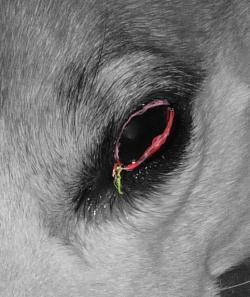Canine and Feline Conjunctivitis
- posted: Oct. 08, 2017
 Why is that Eye so Red?
Why is that Eye so Red?
Cats and dogs can get conjunctivitis characterized by redness, swelling and discharge from the eye for multiple reasons. The conjunctiva is the pink membrane on the inside of the eyelid and the surface of the white part of the eye or sclera. Here, we will discuss a few common causes of conjunctivitis in pets.
Bacterial and viral infections can cause conjunctivitis, but infection is actually less common than other causes, especially in dogs. Cats can frequently develop conjunctivitis secondary to complications from feline herpesvirus. Other causes of conjunctivitis include KCS which stands for keratoconjunctivitis sicca which is the long medical term for what is better known as “dry eye.” In this condition, the eye does not produce enough tears and the eye becomes dry, red and irritated without its normal tear film. The eye will look red and the conjunctival membranes may look swollen. There may also be a thick, mucoid discharge on the surface of the eye as it tries to protect itself without tears.
Allergies can also lead to conjunctivitis in pets as can a turning in or out of the eyelid. If the lid turns under or inward, a condition known as entropion, the eyelashes can rub the eye causing chronic irritation and signs of conjunctivitis. If the lids turn out (ectropion), the eye is less protected and can become dry also leading to conjunctivitis.
In short-nosed or brachycephalic breeds such as pugs or bulldogs, skin folds on the face may be very close to the surface of the eye and may rub the eye causing the familiar redness, swelling and discharge. Growth of hairs or eyelashes in abnormal places such as on the inside of the eyelid can also lead to chronic conjunctivitis.
Tests that may be performed to help diagnose your pet in addition to a visual exam of the eye include checking tear production with a test called a Schirmer Tear Test, checking the pressure inside the eyes to make sure the redness is not being caused by glaucoma and, in some cases, examining cells from the lining of the eyelid. Conjunctivitis is not usually a primary diagnosis; it is usually secondary to some other cause. Treatment would include treating the underlying cause i.e. if the pet has dry eye, topical medications to increase natural tear production would be prescribed, if she has entropion, surgery would be needed to correct the eyelid. Any secondary bacterial or viral infections would also be treated.
As you can see, what seems like a simple “pink eye” infection may not actually be so simple. The underlying cause needs to be discovered and treated for your pet to improve. Untreated conjunctivitis could lead to chronic inflammation, pain and even permanent damage to the pet’s eye that may affect vision. So, if your pet’s eye looks red, have him or her checked right away by your vet so proper treatment can be started.
This blog brought to you by the Patton Veterinary Hospital serving Red Lion, York and the surrounding communities. Source: Clinician’s Brief Conjunctivitis in Dogs https://www.cliniciansbrief.com/article/conjunctivitis-dogs
Location
Patton Veterinary Hospital
425 E Broadway
Red Lion, PA 17356
